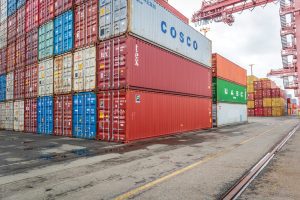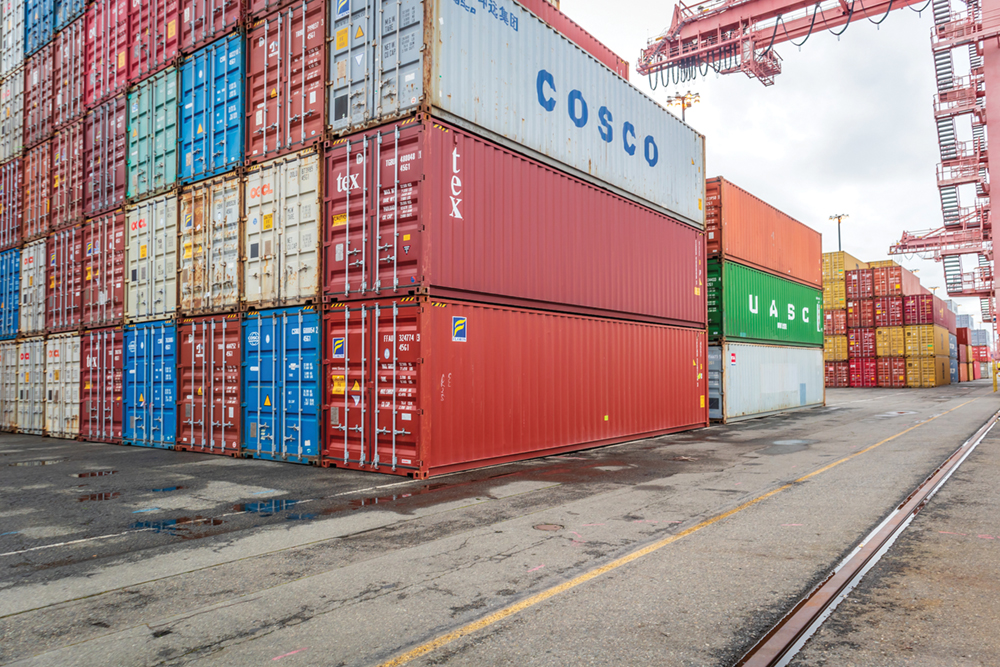
As the world emerges from the COVID-19 pandemic, consumers are expected to eventually shift more of their spending from goods to services, but ongoing gridlock at seaports and recent efforts to decarbonize container vessels may continue to affect ocean freight rates in the trans-Pacific. So said experts at a Feb. 28 panel at the Journal of Commerce’s TPM22 Conference in Long Beach, Calif.
The panel of experts – which included Rahul Kapoor, vice president and head of commodity research, maritime and trade at IHS Markit, and Thorsten Meincke, a board member for logistics company DB Schenker, spoke about the container shipping market in the trans-Pacific and what shippers should expect in the coming years.
Kapoor described an 18-month turnaround of the industry, which appeared to be heading into a recession in 2020 and was expected to see potential bankruptcies. Instead, the last 18 months brought a 47% increase in U.S. consumer spending, resulting in import numbers that shattered cargo records at West Coast seaports last year. In addition, ocean carriers are sending bigger vessels to meet demand as the industry returns to profitability.
“We’re talking about 10 years of demand back in 18 months,” he said. “Demand we haven’t seen since the global financial crisis.”
Kapoor said he expects some of that demand for goods to be resilient, but not as much as the previous year. And while the consumer shift from goods to services hasn’t fully happened yet, he expects it to occur with goods demand normalizing this year as more restrictions relax.
But don’t expect pre-pandemic freight rates any time before 2023-2024, he added. A lot of inventory has already been ordered and is on ships.
“We are looking at rates still being elevated,” he explained.
But Kapoor said he anticipates rates to roll back as congestion gradually eases, some capacity returns and more vessels come online.
While carriers have seen a 31% increase in capacity in the trans-Pacific and elsewhere in the last year, it’s been counteracted by supply-chain disruption, resulting in between 8% and 25% of decreased capacity, Meincke said.
Meanwhile, shipping companies will also have to contend with the possibility of investing in their vessels to meet new decarbonization requirements in the coming years. The International Marine Organization has been pushing to decarbonize cargo vessels—so they must meet a certain threshold for lowering carbon dioxide emissions beginning next year.
That may mean vessel improvements or other strategies to meet IMO requirements, which would become stricter in the coming years, and could affect capacity, Meincke said.
Another complication could be the labor market and lack of workers to fill jobs, especially in maritime and logistics, as companies struggle to find enough people to work, Meincke said.
Meincke said the industry needs to re-adjust supply-chain operations in which shippers need multiple service contracts to ensure stability. A shipper needs at least a stable base contract, and a second-tier contract to account for volatility, he said.
“When carriers come into direct contracting with customers in this environment (with) … technical or actual blank sailings, you cannot have one single payer where you only rely on one carrier,” he said.
Meincke suggested contracting with two or three different alliances.
“Just sticking with one is very tricky and very dangerous,” he remarked.
KAREN ROBES MEEKS, A SOUTHERN CALIFORNIA NATIVE, is an award-winning journalist with more than 20 years’ writing experience. Her articles have appeared in the Los Angeles Times, San Francisco Chronicle, Orange County Register and Long Beach Press-Telegram, where she worked as a reporter for nearly 14 years. Her work has been recognized by the California News Publishers Association, the Associated Press News Executives Council and the Los Angeles Press Club.

